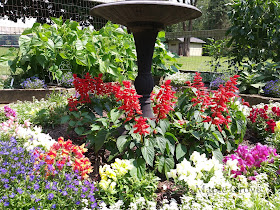 This is my sixth Kitchen Garden since we built the Potting Shed and put in my first garden in 2013. I like to try new things and make changes to the garden each year. The big change this year is the center bed. Inspired by Chris McLaughlin and her new book release, Growing Heirloom Flowers, I decided to plant only flowers in the center bed.
This is my sixth Kitchen Garden since we built the Potting Shed and put in my first garden in 2013. I like to try new things and make changes to the garden each year. The big change this year is the center bed. Inspired by Chris McLaughlin and her new book release, Growing Heirloom Flowers, I decided to plant only flowers in the center bed.
 Center Flower Bed
Center Flower Bed
In the past I have planted tomatoes or peppers in this center bed, but last year I placed the bird bath there, and I don't like planting tall plants around it. I have also planted lettuces and greens here, but they bolt so fast in the heat.

As the garden is planted in full sun, I chose flowers accordingly. An inner row of red salvia circles the bird bath, followed by a middle row of snap dragons and an outer row of white sweet alyssum and blue lobelia.
I also accented with these varieties among my vegetable plants and in the shed's window flower boxes. Geraniums, one of my very favorites, get center stage there.
Vertical Vining Vegetables
McLaughlin has been my mentor for years. Her book on Vertical Vegetable Gardening guided me in my first attempt to garden. Since my garden is small (16x16 feet) I continue to practice the square foot and vertical gardening techniques. This bed has a cucumber plant and a zucchini plant, but growing them vertically enables me to grow them both in a 3x6 foot bed. I was even able to get some kale in between them and used a decorative fence for eye appeal and to separate them from the border flowers.This bed has two types of tomato plants, bell peppers, dill, basil and parsley. The tomato plants are in cages which are also tied to the fencing so the weight of the tomatoes doesn't pull them forward. I planted flowering clematis on the outside of the garden fence. I just planted it this year and it already has a start up the fencing and will eventually climb the gate arbor.
This is another bed with tomato plants, jalapeno peppers, rosemary, sage and thyme, along with some accent fencing, sweet alyssum and lobelia.
The fifth and final bed has bush beans (both green and yellow), with oregano planted in the left triangular corner. Accent fencing helps to confine the bean plants to the space within the bed. I practice crop rotation and rotate plant types from bed to bed each year.
I hope you enjoyed this little tour of my garden and that something in this blog post is helpful to you. I'm already thinking about some changes I will make to my garden next year. That's part of the joy of gardening . . . dreaming about it. Here are some more photos of my Kitchen Garden and Potting Shed. Happy Gardening!











